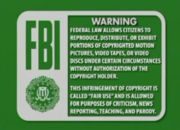Fair Use
From DigitalRhetoricCollaborative
(→Prominent People) |
|||
| Line 1: | Line 1: | ||
[[image:fair_use.png|thumb|FBI Warning with Fair Use mentioned <ref> http://digiteen12--2.flatclassroomproject.org/Copyright,+Fair+Use,+Legal_Social_Awareness </ref>]] | [[image:fair_use.png|thumb|FBI Warning with Fair Use mentioned <ref> http://digiteen12--2.flatclassroomproject.org/Copyright,+Fair+Use,+Legal_Social_Awareness </ref>]] | ||
| - | Fair use <ref> http://www.copyright.gov/fls/fl102.html</ref> is a doctrine included in the U.S. copyright laws that protects the reproduction of copyrighted works for certain circumstances. Under copyright law, any work of literature, art, or intellectual property is protected from outside replication. Fair use allows for the reproduction of these properties without express permission of the author as long as the intention behind the reproduction is beneficial | + | Fair use <ref> http://www.copyright.gov/fls/fl102.html</ref> is a doctrine included in the U.S. copyright laws that protects the reproduction of copyrighted works for certain circumstances. Under copyright law, any work of literature, art, or intellectual property is protected from outside replication. Fair use allows for the reproduction of these properties without express permission of the author as long as the intention behind the reproduction is beneficial for academic learning and not for personal profit or gain. |
Revision as of 13:02, 22 April 2015

Fair use [2] is a doctrine included in the U.S. copyright laws that protects the reproduction of copyrighted works for certain circumstances. Under copyright law, any work of literature, art, or intellectual property is protected from outside replication. Fair use allows for the reproduction of these properties without express permission of the author as long as the intention behind the reproduction is beneficial for academic learning and not for personal profit or gain.
Contents |
Fair Use on the Internet
Court Cases
Legislation about Fair Use
Fair use is referred to as a doctrine, not a law. Being a doctrine means that rulings on this issue are made using other legislation pertaining to the topic of copyrighting.
The doctrine of fair use is not a law by itself, but it is incorporated into multiple other pieces of legislation pertaining to copyright. Below are some of the laws and acts that are used when making cases about fair use.
US Copyright Law
The United States passed the Copyright Act in 1976. This act prevents the unauthorized replication of a work. The copyright only covers the exact replication of a work; the ideas held within the work are not protected. Because of the copyright act, any author or creator is not required to have to register with the copyright office or put a seal on their work; it is automatically protected.
Protection under the copyright law applies to published and unpublished works. These works include any kind of intellectual property such as music, art, literature, etc.
Within the copyright act, there is a provision for the doctrine of fair use in Section 107.
Fair Use - Section 107
Section 107 of the copyright act gives the conditions under which a reproduction of a work is able to be used without gaining permission first. This exemption can be used by teachers and professionals alike to share information and knowledge with peers and students without using valuable time to get permission to share the information.
There are four factors that influence the decision as to whether or not a piece is being used fairly. The factors are:
- The purpose and character of the use, including whether such use is of commercial nature or is for nonprofit educational purposes
- The nature of the copyrighted work
- The amount and substantiality of the portion used in relation to the copyrighted work as a whole
- The effect of the use upon the potential market for, or value of, the copyrighted work
All of these factors should be taken into consideration when using another person's works. There is a lot of freedom within the parameters of fair use for property to be redistributed, but because of that freedom the lines guarding the copyright are also a little blurred.
FAIR USE Act
- The FAIR USE Actalso deals with the idea of copyrighting and redistribution, but it has a different agenda. FAIR USE stands for “Freedom and Innovation Revitalizing United States Entrepreneurship Act of 2007”. This was a proposed law that was never passed, but it posed problems for the Digital Millenium Copyright Act.
Digital Millennium Copyright Act
- The Digital Millennium Copyright Act [3] was passed in 1998 by President Bill Clinton as an amendment to the Copyright Act focusing on bringing copyright into the digital realm. It gave heavier penalties for copyright infringement on the internet along with criminalizing measures taken to obtain copyrighted work on the web without proper permission. The DMCA implements two different treaties created in 1996 by the World intellectual Property Organization (WIPO). The treaties included are the WIPO Copyright Treaty and the WIPO Performances and Phonograms Treaty.
Prominent People
Hector Postigo [4] - “The Digital Rights Movement:The Role of Technology in Subverting Digital Copyright”
Dr. Postigo is an Associate Professor at Temple University in Philadelphia, Pennsylvania. He teaches in the Department of Broadcasting, Telecommunications, and Mass Media. He has written two books that focus on the Digital Rights movement and the effect on copyright laws.
